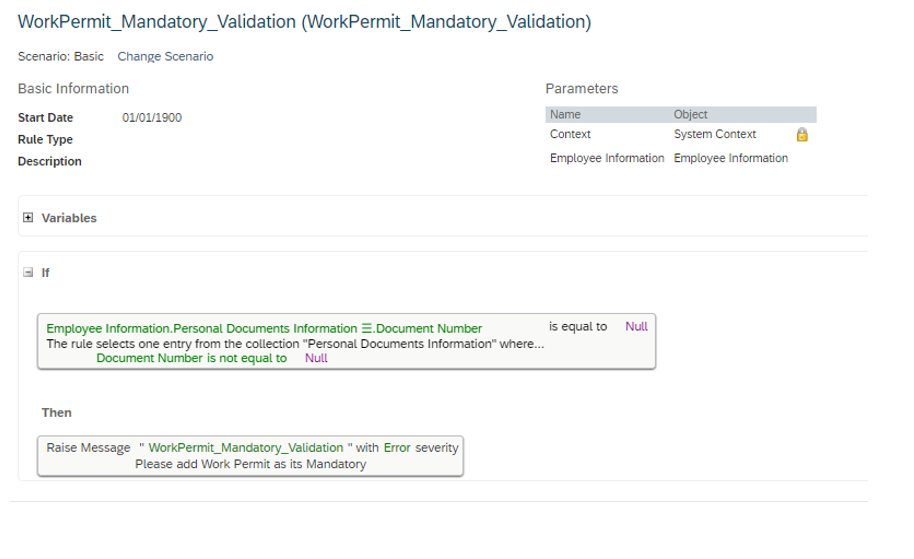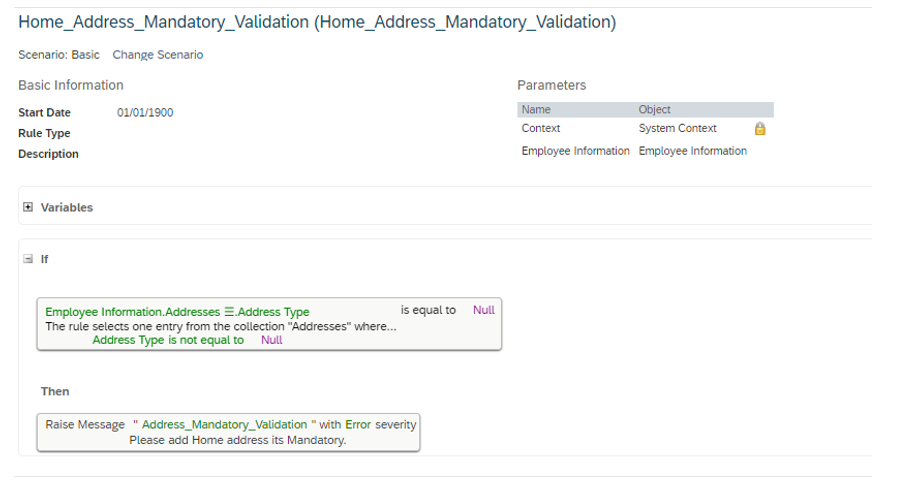
- SAP Community
- Products and Technology
- Human Capital Management
- HCM Blogs by SAP
- SAP SuccessFactors Onboarding: Onboarding Rule Con...
Human Capital Management Blogs by SAP
Get insider info on HCM solutions for core HR and payroll, time and attendance, talent management, employee experience management, and more in this SAP blog.
Turn on suggestions
Auto-suggest helps you quickly narrow down your search results by suggesting possible matches as you type.
Showing results for
Advisor
Options
- Subscribe to RSS Feed
- Mark as New
- Mark as Read
- Bookmark
- Subscribe
- Printer Friendly Page
- Report Inappropriate Content
12-07-2021
8:20 PM
Rules Validations in New Hire Data Review and Personal Data Collection
Onboarding has multiple data review steps and sometimes there is a requirement when we want some data to be entered mandatorily by the hiring manager/responsible onboarding participant or new hire. This cannot be achieved by marking the fields mandatory at data model level as it makes it mandatory for both hiring manager/responsible onboarding participant or new hire. To avoid this we can make use of rules. An onSave rule can help in doing such validations. This rule needs to be added at the corresponding entity on Admin > Manage Business Configuration screen.
Scenario 1: Making at least one Email information to be mandatorily entered by the new hire
In this scenario we are trying to make sure that when the new hire performs Personal Data Collection, the new hire must at least enter one Email address information.

Scenario 2: Making at least one Email information to be mandatorily entered by the hiring manager/responsible onboarding participant and the new hire
In this scenario we are trying to make sure that when the hiring manager/responsible onboarding participant performs New Hire Data Review, or the new hire performs Personal Data Collection, they must enter at least one Email address information.

Scenario 3: Making Personal Email Information to be mandatorily entered by hiring manager/responsible onboarding participant and the new hire
In this scenario we are trying to make sure that when the hiring manager/responsible onboarding participant performs New Hire Data Review, or the new hire performs Personal Data Collection, they must enter Email address of type “personal”.

Scenario 4: Making Personal Email information to be mandatorily entered by the new hire
In this scenario we are trying to make sure that when the new hire performs Personal Data Collection, the new hire must enter Email address of type “personal”.

Scenario 5: Making Job Relationship (HR manager) fields to be mandatorily entered by the manager
In this scenario we are trying to make sure that when the hiring manager/responsible onboarding participant performs New Hire Data Review, this user must enter details of HR Manager in Job Relationship. Since Job Relationship portlet is not shown to the new hire, this rule will not execute.

Scenario 6: Making National ID fields to be mandatorily entered by the new hire
In this scenario we are trying to make sure that when the new hire performs Personal Data Collection, the new hire must enter at least one National ID information to be displayed as the primary National ID on the user interface.

Scenario 7: Making Work Permit fields to be mandatorily entered by hiring manager/responsible onboarding participant and the new hire
In this scenario we are trying to make sure that when the hiring manager/responsible onboarding participants performs New Hire Data Review, or the new hire performs Personal Data Collection, they must enter at least one Work Permit Information.

Scenario 8: Making Phone Info fields to be mandatorily entered by the new hire
In this scenario we are trying to make sure that when the new hire performs Personal Data Collection, the new hire must enter at least one Phone Information.

Scenario 9: Making Pay Component Recurring fields to be mandatorily entered by hiring manager/responsible onboarding participant
In this scenario we are trying to make sure that when the hiring manager/responsible onboarding participant performs New Hire Data Review, this user enters details of at least one Pay Component Recurring. Since Pay Component Recurring Portlet is not shown to the new hire, this rule will not execute.

Scenario 10: Making Pay Component Non Recurring (Bonus) fields to be mandatorily entered by hiring manager/responsible onboarding participant
In this scenario we are trying to make sure that when the hiring manager/responsible onboarding participant performs New Hire Data Review, this user must enter details of at least one Pay Component Non-Recurring with type Bonus. Since the Pay Component Non-Recurring portlet is not shown to the new hire, this rule will not execute.

Scenario 11: Making Social Information fields to be mandatorily entered by the new hire
In this scenario we are trying to make sure that when a new hire performs Personal Data Collection, the new hire must enter at least one Social Information.

Scenario 12: Making Home Address fields to be mandatorily entered by hiring manager/responsible onboarding participant and the new hire
In this scenario we are trying to make sure that when the hiring manager/responsible onboarding participant performs New Hire Data Review, or the new hire performs Personal Data Collection, they must enter at least one Home Address details.

Onboarding Rules - A way to differentiate between Onboarding and Employee Central new hires
Whenever we define rules today, we come across questions/scenarios where we want to execute some rules as part of onboarding process and others as part of Manage Pending Hires. There are some instances where we may be willing to set different workflow configurations for Onboarding new hires and Employee Central new hires via Admin > Add New Hires (here after referred as EC).
So, the question comes is how can we identify if a user is hired through Onboarding or Employee Central. In we will be discussing a solution to this problem.
Whenever Onboarding is initiated, a process object is created and that represents the current state of the new hire in the system. So we can check if a Process Object exists to verify that a user is an Onboarding Hire. The status of process object can change based on actions such as cancel/restart and completion.
Scenario 1: Rule to differentiate workflow configuration for EC hires and Onboarding hires in HRIS entities during hiring (Manage Pending Hires)
Workflows can be configured for “Add New Hire” and from “Manage Pending Hires” steps. In case you want different workflows for new hires from Onboarding and Employee Central, you can use the following rule conditions.
The lookup function can be used to identify which workflow will execute for Onboarding users.

Scenario 2: Rule to skip workflow configuration for Onboarding hires in MDF objects at Personal Data Collection, when they are external hires, and they are not hired yet.
Here we will be using the lookup function to identify if the user for whom we are executing the steps is in Manage Pending Hire and being performed by the new hire.
In the following rule we are skipping Workflow configuration when the onboarding new hire adds the Payment Information in the system as part of personal Data Collections. This rule ensures that workflow is triggered workflow is triggered when hiring is done under the categories of Onboarding and Employee Central hires.
This is a sample rule and else condition can be enhanced if we want to have multiple workflow configurations for different types of hires. We must ensure that condition to skip Workflow configuration setting is the first condition.

Conclusion:
As part of this blog we went through how can we configure rules for Responsible users or new hire to enforce validations and also how can we differentiate onboarding new hire and Employee Central Hire in Rules.
- SAP Managed Tags:
- SAP SuccessFactors Onboarding
Labels:
8 Comments
You must be a registered user to add a comment. If you've already registered, sign in. Otherwise, register and sign in.
Labels in this area
-
1H 2023 Product Release
3 -
2H 2023 Product Release
3 -
Business Trends
104 -
Business Trends
4 -
Cross-Products
13 -
Event Information
75 -
Event Information
9 -
Events
5 -
Expert Insights
26 -
Expert Insights
15 -
Feature Highlights
16 -
Hot Topics
20 -
Innovation Alert
8 -
Leadership Insights
4 -
Life at SAP
67 -
Life at SAP
1 -
Product Advisory
5 -
Product Updates
499 -
Product Updates
28 -
Release
6 -
Technology Updates
408 -
Technology Updates
6
Related Content
- Is SAP embedded signature supported for Recruiting Offer letters in Human Capital Management Q&A
- Automatic Hire in Human Capital Management Blogs by SAP
- Late Coming and Early Departure Detection for Double Shifts on the same day - SF Time Tracking in Human Capital Management Blogs by Members
- Transforming Supplementary Data Gathering at Additional Data Collection Step into PDF Form in Human Capital Management Blogs by Members
- From Code to Logic: XML to Business Rule Shift in Human Capital Management Blogs by Members
Top kudoed authors
| User | Count |
|---|---|
| 4 | |
| 4 | |
| 2 | |
| 2 | |
| 2 | |
| 2 | |
| 2 | |
| 1 | |
| 1 | |
| 1 |